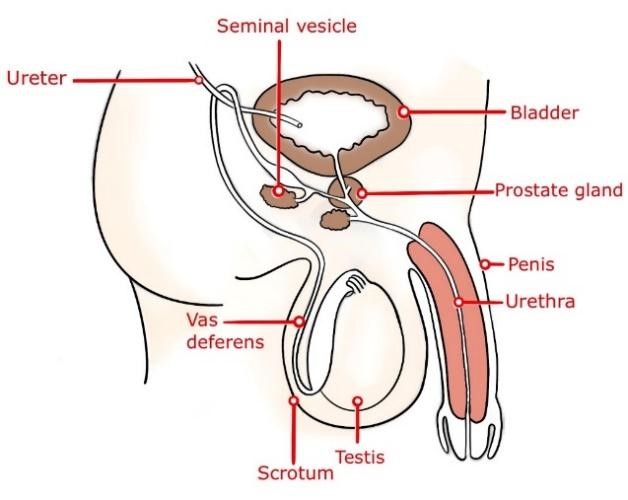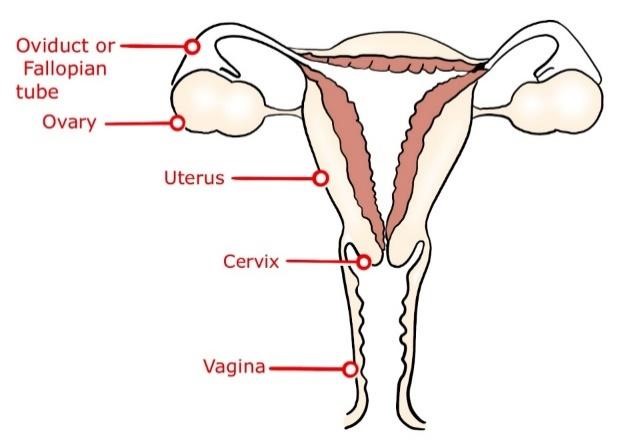Introduction
Making copies of body design blueprints are referred to as reproduction. The generation of DNA copies is the most basic event in reproduction. DNA (Deoxyribonucleic Acid) molecules in chromosomes in the nucleus of a cell contain information for the inheritance of traits from parents to the next generation.
Humans use a sexual mode of reproduction. It is done by specialised cell types by the creation of germ cells.
- The period when reproductive tissues begin to mature is known as puberty
- It activates the creation of germ cells to participate in sexual reproduction
- It brings changes in the body at puberty, such as an increase in breast size in girls and new facial hair growth in boys, which are signs of sexual maturation
- The sexual act necessitates the use of particular organs for the actual transfer of germ cells between two humans
Male Reproductive System
- The male reproductive system comprises a number of sex organs and hence contributes to the human reproductive process.
- Male Reproductive System consists of external genital organs and internal genital organs
- External genital organs include the penis and scrotum whereas internal genital organs include testis, epididymis, vas deferens, and accessory glands – seminal vesicles, prostate gland, and bulbourethral glands (Cowper’s gland)
- The testes are oval-shaped organs where germ cells or sperms and the hormone testosterone are formed
- Testosterone is the primary male sex hormone
- Sperms are tiny bodies that comprise principally hereditary materials and a long tail that assists them in swimming toward the female microbe cell
- The function of sperm is to carry genetic information
- Head region of sperm contains DNA, while the middle piece has mitochondria, and the tail region has a flagellum that helps in moving in a forwarding direction
- The process of the formation of sperm is called spermatogenesis
- The site of spermatogenesis in the seminiferous tubules
- The pathway of sperm in the male reproductive process is as follows:
Testes → Epididymis → Vas deferens → Ejaculatory Duct → Urethra
- Glands like the prostate and the fundamental vesicles add their emissions, so the sperms stay in a liquid which makes their vehicle simpler
- This liquid additionally gives nourishment


Female Reproductive System
- The Female Reproductive System produces an egg or ovum, and hormones like oestrogen and progesterone
- Female reproductive system supports developing embryos
- Major organs of female reproductive organs include- the cervix, vagina, gonads (ovaries), uterine tubes or fallopian tubes, and uterus
- These are mainly part of the organs of internal genitalia. The external genitalia also called vulva include – mons pubis, labia, clitoris, and vestibule structures
- In the ovaries, female germ cells or eggs are produced
- A narrow oviduct or fallopian tube transports the egg from the ovary to the womb
- The uterus is an elastic bag-like structure having a pear shape that connects the two oviducts
- Through the cervix, the uterus enters the vaginal canal
- During sexual intercourse, sperm enter through the vaginal channel
- They ascend to the oviduct, where they may come across the egg (fertilisation)
- The fertilised egg (zygote) begins to divide and eventually forms a ball of cells or embryo
- The embryo is implanted in the lining of the uterus, where they continue to grow and develop organs to become a foetus
- With the help of a special tissue called the placenta, the embryo receives nutrition from the mother’s blood
- It takes about nine months for the child to develop inside the mother’s body
- The baby is born as a result of the uterus’ muscles contracting in a rhythmic pattern
Contraceptive Methods
This includes methods to avoid pregnancy such as:
- A mechanical barrier so sperm doesn’t arrive at the egg, for example, Condoms on the penis or comparable covers worn in the vagina
- Changing the hormonal balance of the body so that eggs are not released and fertilisation cannot occur
- Contraceptive methods in females include- spacing methods, terminal methods, and pregnancy vaccines
- Spacing methods further include rhythm methods, barrier methods, and chemical methods
Menstruation
- Menstruation, also known as period, is a part of women’s monthly cycle
- During menstruation normal vaginal bleeding occurs
- The length of a menstruation cycle of a woman varies from one another
- But to have a period after every 28 days is considered as normal
- Every month a woman’s body prepares for pregnancy If no pregnancy occurs then the uterus sheds its lining
- Then menstruation occurs
- Menstrual blood is actually partly tissue or partly blood from inside the uterus
- The uterus sets itself up consistently to get a treated egg, and its covering turns out to be thick and light
- If the egg is not fertilised, the lining slowly breaks and comes out through the vagina as blood and mucous
- Menarche is the onset of menstruation, whereas menopause is the ceasing of the menstrual cycle
- On an average, by age 51 of a woman, the ovaries stop releasing eggs and then periods stop
Conclusion
Humans are sexually reproducing animals and give birth to young ones, so that’s why called as viviparous animals. The male reproductive system consists of a pair of testes, accessory ducts and the accessory glands and external genitalia. Testes have testicular compartments called testicular lobules which contain seminiferous tubules. These seminiferous tubules are further lined by Sertoli cells and spermatogonia. The Leydig cell synthesises and secrete male reproductive hormones called androgens. The female reproductive system consists of a pair of ovaries, a pair of oviducts, a vagina, external genitalia, and a pair of mammary glands. The ovaries produce female gonads called ovum and some steroidal hormones. Oogenesis is the formation of mature female gametes whereas spermatogenesis is the formation of mature male gametes. Menstrual cycle is the part of the female reproductive system which starts only after attaining the sexual maturity or puberty.
 Profile
Profile Settings
Settings Refer your friends
Refer your friends Sign out
Sign out












